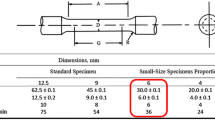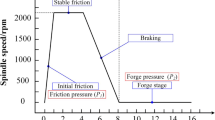Abstract
A high strength aluminum alloy has been widely employed in aerospace industry because of its high specific strength to weight ratio. Earlier, the fusion welding of aluminum alloys resulted in solidification cracking and shrinkage defects. To eliminate these drawbacks, the solid-state welding processes have been preferred to join the components of parts of armor grade aluminum alloy. This paper is devoted to the analysis of the mechanical properties and metallurgical characteristics of rotary friction welded aluminum alloy joints produced under optimized conditions. The maximum recorded transverse tensile strength and joint efficiency is of 472 MPa and 86%, respectively. The microstructural features exhibited ultrafine grains in the region of a fully-deformed zone (FDZ) of the alloy. The deformed grains in the thermomechanical affected zone (TMAZ) were recorded to have lower microhardness. Although, the dispersed precipitates revealed from the weld cross section were Al7Cu2Fe, Mg3Cr2Al18, and MgZn2. From this investigation, it has been found that most of the weld failures occurred due to grain deformation and subsequent softening during solidification.







Similar content being viewed by others
REFERENCES
Y. Yang, P. Hua, X. Li, K. Chen, et al., “Effect of multipass on microstructure and impact toughness of As-cast Al–20Si alloy via friction stir processing,” Phys. Met. Metallogr. 120, 1126–1132 (2019).
E. D. Nicholas, “Friction processing technologies,” Weld. World 47, 2–9 (2003).
M.B. Uday, et al., “Advances in friction welding process: a review,” Sci. Technol. Weld. Join. 15 (7), 534–558 (2010).
A. Garg, M. Raturi, and A. Bhattacharya, “Strength, failure, and microstructure development for friction stir welded AA6061-T6 joints with different tool pin profiles,” CIRP J. Manuf. Sci. Technol. 29, 99–114 (2020).
C. Yang, et al., “Microstructure and mechanical properties of double-side friction stir welded 6082Al ultra-thick plates,” J. Mater. Sci. Technol. 41, 105–116 (2020).
S. A. Khodir and T. Shibayanagi, “Friction stir welding of dissimilar AA2024 and AA7075 aluminum alloys,” Mater. Sci. Eng., B 148 (1–3), 82–87 (2008).
A. R. McAndrew, P. A. Colegrovea, et al., “A literature review of Ti–6Al–4V linear friction welding,” Prog. Mater. Sci. 92, 225–257 (2018).
H. K. Rafi, G. D. Janaki Ram, G. Phanikumar, and K. Prasad Rao, “Microstructure and tensile properties of friction welded aluminum alloy AA7075-T6,” Mater. Des. 31 (5), 2375–2380 (2010).
M. N. Ahmad Fauzi, M. B. Uday, H. Zuhailawati, and A. B. Ismail, “Microstructure and mechanical properties of alumina-6061 aluminum alloy joined by friction welding,” Mater. Des. 31 (2), 670–676 (2010).
S. Rajakumar, C. Muralidharan, and V. Balasubramanian, “Influence of friction stir welding process and tool parameters on strength properties of AA7075-T6 aluminum alloy joints,” Mater. Des. 32 (2), 535–549 (2011).
L. Fratini, G. Buffa, and R. Shivpuri, “Mechanical and metallurgical effects of in-process cooling during friction stir welding of AA7075-T6 butt joints,” Acta Mater. 58 (6), 2056–2067 (2010).
I. Bhamji, et al., “Linear friction welding of aluminum to magnesium,” Sci. Technol. Weld. Joining 17 (5), 368–374 (2012).
P. Sivaraj, M. Vinoth Kumar, and V. Balasubramanian, “Microstructural characteristics and tensile properties of linear friction-welded AA7075 aluminum alloy joints,” in Proceedings of ICEMMM 2018 Advances in Materials and Metallurgy (Springer-Verlag, Singapore, 2019), pp. 467–476.
K. V. Jata, K. K. Sankaran, and J. J. Ruschau, “Friction-stir welding effects on microstructure and fatigue of aluminum alloy 7050-T7451,” Metall. Mater. Trans. A 31, 2181–2192 (2000).
X. Y. Wang, W. Y. Li, T. J. Ma, and A. Vairis, “Characterization studies of linear friction welded titanium joints,” Mater. Des. 116, 115–126 (2017).
A. Chamanfar, et al., “Mechanical property and microstructure of linear friction welded WASPALOY,” Metall. Mater. Trans. A 42, 729–744 (2011).
M. Ilangovan, S. R. Boopathy, and V. Balasubramanian, “Microstructure and tensile properties of friction stir welded dissimilar AA6061–AA5086 aluminum alloy joints,” Trans. Nonferrous Met. Soc. China 25 (4), 1080–1090 (2015).
R. K. R. Singh, C. Sharma, D. K. Dwivedi, N. K. Mehta, and P. Kumar, “The microstructure and mechanical properties of friction stir welded Al–Zn–Mg alloy in as-welded and heat treated conditions,” Mater. Des. 32 (2), 682–687 (2011).
Y. Ji, Z. Chai, D. Zhao, and S. Wu, “Linear friction welding of Ti–5Al–2Sn–2Zr–4Mo–4Cr alloy with dissimilar microstructure,” J. Mater. Process. Technol. 214 (4), 979–987 (2014).
C. Sharma, D. K. Dwivedi, and P. Kumar, “Influence of in-process cooling on tensile behavior of friction stir welded joints of AA7039,” Mater. Sci. Eng., A 556, 479–487 (2012).
N. R. J. Hynes and P. S. Velu, “Effect of rotational speed on Ti–6Al–4V–AA 6061 friction welded joints,” J. Manuf. Process. 32, 288–297 (2018).
P.-H. Geng, G.-L. Qin, Z. Jun, and C.-A. Li, “Parametric optimization, and microstructural characterization of friction welded aeronautic aluminum alloy 2024,” Trans. Nonferrous Met. Soc. China 29 (12), 2483–2495 (2019).
P. Sivaraj, P. Hariprasath, C. Rajarajan, and V. Balasubramanian, “Analysis of grain refining and subsequent coarsening along on adjacent zone of friction stir welded armor grade aluminum alloy joints,” Mater. Res. Express 6 (6), 066566 (2019).
Z. Barlas and U. Ozsarac, “Effects of FSW parameters on joint properties of AlMg3 alloy,” Weld. J. 91 (1), 16–22 (2012).
Y. S. Sato and H. Kokawa, “Distribution of tensile property and microstructure in friction stir weld of 6063 aluminum,” Metall. Mater. Trans. A 32, 3023–3031 (2001).
K. V. Jata and S. L. Semiatin, “Continuous dynamic recrystallization during friction stir welding of high strength aluminum alloys,” Scr. Mater. 43, 743–749 (2000).
S. R. S. Bharathi, R. Rajeshkumar, A. Razal Rose, and V. Balasubramanian, “Mechanical properties and microstructural characteristics of friction welded dissimilar joints of aluminum alloys,” Trans. Indian Inst. Met. 71, 91–97 (2018).
X. Li, et al., “Effect of rotation speed on friction behavior of rotary friction welding of AA6061-T6 aluminum alloy,” Weld. World 62, 923–930 (2018).
L. Fratini, G. Buffa, M. Cammalleri, and D. Campanella, “On the linear friction welding process of aluminum alloys: Experimental insights through process monitoring,” CIRP Ann. 62 (1), 295–298 (2013).
S. D. Ji, Y. Y. Jin, Y. M. Yue, S. S. Gao, Y. X. Huang, and L. Wang, “Effect of temperature on material transfer behavior at different stages of friction stir welded 7075-t6 aluminum alloy,” J. Mater. Sci. Technol. 29 (10), 955–960 (2013).
J. He, Z. Ling, and H. Li, “Effect of tool rotational speed on residual stress, microstructure, and tensile properties of friction stir welded 6061-T6 aluminum alloy thick plate,” Int. J. Adv. Manuf. Technol. 84, 1953–1961 (2016).
P. Sivaraj, D. Kanagarajan, and V. Balasubramanian, “Effect of post-weld heat treatment on tensile properties and microstructure characteristics of friction stir welded armor grade AA7075-T651 aluminum alloy,” Def. Technol. 10 (1), 1–8 (2014).
Author information
Authors and Affiliations
Corresponding author
Rights and permissions
About this article
Cite this article
Hariprasath, P., Sivaraj, P. & Balasubramanian, V. A Critical Assessment on Rotary Friction Welded High Strength Armor Grade Aluminum Alloy Joints. Phys. Metals Metallogr. 122, 1401–1408 (2021). https://doi.org/10.1134/S0031918X21130044
Received:
Revised:
Accepted:
Published:
Issue Date:
DOI: https://doi.org/10.1134/S0031918X21130044




